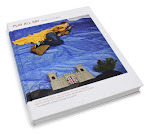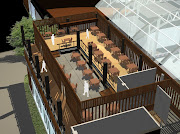Tuesday, June 30, 2009
 Breakfast at Lebuh Armenian: Curry Mee and Hokien Mee
Breakfast at Lebuh Armenian: Curry Mee and Hokien Mee
All the shops around Georgetown area open quite late and sometimes have to walk far to get breakfast.
Kek Lo Si Temple




Queensbay Mall
Day 2
Georgetown area
Traditional shophouses with beautiful ornaments and openings
Most of the roads in the core area have installed signage which explains the history of the roads and the brief stories behind the road.  Breakfast at Kopitiam: Kueh Teow Sup, Roti Bakar, Coffee, Teh
Breakfast at Kopitiam: Kueh Teow Sup, Roti Bakar, Coffee, Teh
Hock Teik Cheng Sin Temple
There are explanations on board available for most of the heritage buildings.
 It also explains the floor layout, architectural features, conservation techniques and important events held here before.
It also explains the floor layout, architectural features, conservation techniques and important events held here before. 

The temple floor finishes nowadays are different from the origin floor patterns. Visitors still can see the original patterns through the box above.
Cheah Kongsi
There are a few chinese kongsi or clan associations in Georgetown, and this is one of unique architecture in Penang.
 The Cheah Kongsi clan association was founded in 1820 by Cheah Yam, an immigrant who originally hailed from Sek Tong village in South China. Upon his death, his widow Ong Sin Neoh took charge of the association and created the legal mechanisms and trust funds to ensure that the association would continue into perpetuity. Her son, Cheah Choo Yew, and his succeeding descendants have served as the presidents of the clan association ever since.
The Cheah Kongsi clan association was founded in 1820 by Cheah Yam, an immigrant who originally hailed from Sek Tong village in South China. Upon his death, his widow Ong Sin Neoh took charge of the association and created the legal mechanisms and trust funds to ensure that the association would continue into perpetuity. Her son, Cheah Choo Yew, and his succeeding descendants have served as the presidents of the clan association ever since.  The Cheah clan temple is an eclectic mix of a Chinese mansion, Chinese temple, and European bungalow. The present temple building dates from the 1870s. The premises also include a similarly eclectic office building and surrounding rentable properties.
The Cheah clan temple is an eclectic mix of a Chinese mansion, Chinese temple, and European bungalow. The present temple building dates from the 1870s. The premises also include a similarly eclectic office building and surrounding rentable properties.(source: orientalarchitecture )
Khoo Kongsi
 The Khoo Kongsi is a clan association of the Leong San Tong (Dragon Mountain Hall) clan who came from the Sin Kang clan village in Hokkien province, China. Their clan temple was erected here in 1906 at the peak of their prosperity.
The Khoo Kongsi is a clan association of the Leong San Tong (Dragon Mountain Hall) clan who came from the Sin Kang clan village in Hokkien province, China. Their clan temple was erected here in 1906 at the peak of their prosperity.  At that time the various clan members lived in the nearby houses and practiced a measure of self-government. The temple is fairly unusual in that it is located away from the street. To reach it, one has to enter through the narrow street-side entrance , then turn a corner twice through a side street to reach the central compound.
At that time the various clan members lived in the nearby houses and practiced a measure of self-government. The temple is fairly unusual in that it is located away from the street. To reach it, one has to enter through the narrow street-side entrance , then turn a corner twice through a side street to reach the central compound.
(source: orientalarchitecture )
The stage opposite with the temple. 

Wall mural of deities



 Ground floor of the temple is used as a gallery explaning about Khoo Kongsi
Ground floor of the temple is used as a gallery explaning about Khoo Kongsi
Cheong Fatt Tze Mansion

We took a 3pm guided tour around the house. The tour costs RM12 and it is really worth it. However, photographs are not allowed in the house.
 The house was designed with full concern of fengshui elements as Chinese believe that good feng shui generate good Qi in the house and also wealthy to the family. Once in the house, can feel comfortable breezes and air circulation although no air-conditioning is switch on.
The house was designed with full concern of fengshui elements as Chinese believe that good feng shui generate good Qi in the house and also wealthy to the family. Once in the house, can feel comfortable breezes and air circulation although no air-conditioning is switch on. According to the guide, the house was aimed to be both office and family residential. The front part of ground floor area is a public space to meet people, while the courtyard area is family spaces. A very delicate partition with natural ornaments paint in gold used to divide the public space and private space.
According to the guide, the house was aimed to be both office and family residential. The front part of ground floor area is a public space to meet people, while the courtyard area is family spaces. A very delicate partition with natural ornaments paint in gold used to divide the public space and private space. 
Cheong Fatt Tze choose to paint his mansion in blue color because he prefered colors that are related to nature, like water. The house was raised up at the entrance area to show the high status of the owner of the house.
 The decoration at roof eave and wall are the famous Chien Nie techniques from China.
The decoration at roof eave and wall are the famous Chien Nie techniques from China.More info
Prangin Mall
Gurney drive+ Gurney Plaza
Gurney Drive is a place where you can get some hawker food and enjoy the sea breezes. The food is not so delicious, but the environment is worth it.



Jalan Munturi 
 Lorong Stewart
Lorong Stewart
Ipoh, perak
Going down to Ipoh using bus.
Hotel Lotte
We stayed at Hotel Lotte in Ipoh town area and a standard room cost RM63 per night. The rooms are very clean and service is good.
 Dinner: Ipoh famous Tauge chicken
Dinner: Ipoh famous Tauge chicken
Day 4
Kellie Castle, Batu Gajah


"Wiliam Kellie Smith was born in Dallas, North-Eastern Scotland to a farmer and his wife on March 1, 1870, William Kellie-Smith travelled to Malaysia, then Malaya, at the tender age of 20 to seek his fortune. Kellie was his mother's maiden name. Smith was engaged by an estate owner named Alma Baker to help in the construction of public roads in South Perak. With this share of the profits from the venture, he bought 1,000 acres of jungle land in the Kinta District, and cleared it to plant rubber.He later named the estate Kinta Kellas, after his home farm, Easter Kellas. "

Wiliam brought 70 tough workers from Madras for the construction of the mansion. However, the workers died suddenly due to some unknown disease. Therefore, Wiliam decided to build a Hindu temple nearby to calm the spirit. There is a secret tunnel which connects the temple with the mansion.








The mansion is designed with rich Moorish style and most of the spaces are well planned. At the ground floor are the living room, prayer hall and dining hall. There is an attached building at the side of the main building which used as servant house and kitchen.



 At the first floor, you will find Wiliam's master bedroom, Helen's (Wiliam daughter) room and his son rooms. Every bedrooms are equipped with changing rooms. A corridor with rich Moorish arches lead ones from one room to another.
At the first floor, you will find Wiliam's master bedroom, Helen's (Wiliam daughter) room and his son rooms. Every bedrooms are equipped with changing rooms. A corridor with rich Moorish arches lead ones from one room to another. 




There are also store rooms to keep wine, pillows, blankets and others. Hidden staircase which lead to underground space left a mysterious stories nowadays.




Wiliam Smith planned to install a bucket lift at the tower, if it was successfully installed during that time, it will be the first lift ever in Malaysia. You can still see the lift shaft which connects to the roof top.


 At the roof top, one will be amazed with the tennis court . The owner actually planned to have an indoor tennis court at the roof top.
At the roof top, one will be amazed with the tennis court . The owner actually planned to have an indoor tennis court at the roof top.  Besides that, there is a watch platform which will be the place where Wiliam can stand and watch the whole Ipoh area.
Besides that, there is a watch platform which will be the place where Wiliam can stand and watch the whole Ipoh area. 


Kek Lo Tong




 Yee Hup -most famous biscuit shop in Ipoh
Yee Hup -most famous biscuit shop in IpohIpoh parade- the biggest shopping mall in Ipoh
Back Penang using bus
 Check in Cititel
Check in Cititel  the view from our room
the view from our roomDay 5
Ghee Xiang
 The most famous shop selling biscuits
The most famous shop selling biscuitsPenang Airport back to kuching---the end of the trip














